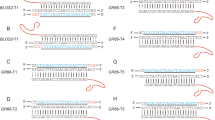Abstract
RNAi knockdown by using shRNA expression plasmids is widely used to determine the function of individual genes in mammals. Here we developed a simple method to create an IR DNA in a U6 small nuclear RNA promoter-based parent vector using a single-stranded IR DNA with short hairpin structure and Bst DNA polymerase. Furthermore, we demonstrated that the shRNA expression plasmids constructed by our method effectively induced target-specific RNAi in the silkworm cell line. We also found that sequence preference in the silkworm cell line was much lower than in mammalian cells and shRNA-induced RNAi was influenced by the length of the stem region.




Similar content being viewed by others
Abbreviations
- shRNA:
-
Short hairpin RNA
- RNAi:
-
RNA interference
- IR:
-
Inverted repeat
- Nt:
-
Nucleotides
- siRNA:
-
Short interference RNA
- dsRNA:
-
Double-stranded RNA
- PCR:
-
Polymerase chain reaction
- Rluc:
-
Renilla luciferase
- EGFP:
-
Enhanced green fluorescent protein
References
Agrawal, N., Dasaradhi, P. V., Mohmmed, A., Malhotra, P., Bhatnagar, R. K., & Mukherjee, S. K. (2003). RNA interference: Biology, mechanism, and applications. Microbiology and Molecular Biology Reviews, 67, 657–685. doi:10.1128/MMBR.67.4.657-685.2003.
Dawe, R. K. (2003). RNA interference, transposons, and the centromere. The Plant Cell, 15, 297–301. doi:10.1105/tpc.150230.
Fire, A., Xu, S., Montgomery, M. K., Kostas, S. A., Driver, S. E., & Mello, C. C. (1998). Potent and specific genetic interference by double-stranded RNA in Caenorhabditis elegans. Nature, 391, 806–811. doi:10.1038/35888.
Hannon, G. J. (2002). RNA interference. Nature, 418, 244–251. doi:10.1038/418244a.
Denli, A. M., & Hannon, G. J. (2003). RNAi: An ever-growing puzzle. Trends in Biochemical Sciences, 28, 196–201. doi:10.1016/S0968-0004(03)00058-6.
McManus, M. T., & Sharp, P. A. (2002). Gene silencing in mammals by small interfering RNAs. Nature Reviews. Genetics, 3, 737–747. doi:10.1038/nrg908.
Zamore, P. D. (2002). Ancient pathways programmed by small RNAs. Science, 296, 1265–1269. doi:10.1126/science.1072457.
Hammond, S. M., Bernstein, E., Beach, D., & Hannon, G. J. (2000). An RNA-directed nuclease mediates post-transcriptional gene silencing in Drosophila cells. Nature, 404, 293–296. doi:10.1038/35005107.
Brummelkamp, T. R., Bernards, R., & Agami, R. (2002). A system for stable expression of short interfering RNAs in mammalian cells. Science, 296, 550–553. doi:10.1126/science.1068999.
Dykxhoorn, D. M., Novina, C. D., & Sharp, P. A. (2003). Killing the messenger: Short RNAs that silence gene expression. Nature Reviews. Molecular Cell Biology, 4, 457–467. doi:10.1038/nrm1129.
Konet, D. S., Anderson, J., Piper, J., Akkina, R., Suchman, E., & Carlson, J. (2007). Short-hairpin RNA expressed from polymerase III promoters mediates RNA interference in mosquito cells. Insect Molecular Biology, 16, 199–206. doi:10.1111/j.1365-2583.2006.00714.x.
Wakiyama, M., Matsumoto, T., & Yokoyama, S. (2005). Drosophila U6 promoter-driven short hairpin RNAs effectively induce RNA interference in Schneider 2 cells. Biochemical and Biophysical Research Communications, 331, 1163–1170. doi:10.1016/j.bbrc.2005.03.240.
Isobe, R., Sahara, K., Asano, S., & Bando, H. (2002). Antisense and double-strand RNA interference in a silkworm ovarian cell line. Journal of Insect Biotechnology and Sericology, 71, 43–47.
Katsuma, S., Mita, K., & Shimada, T. (2007). ERK- and JNK-dependent signaling pathways contribute to Bombyx mori nucleopolyhedrovirus infection. Journal of Virology, 81, 13700–13709. doi:10.1128/JVI.01683-07.
Tsukioka, H., Takahashi, M., Mon, H., Okano, K., Mita, K., Shimada, T., et al. (2006). Role of the silkworm argonaute2 homolog gene in double-strand break repair of extrachromosomal DNA. Nucleic Acids Research, 34, 1092–1101. doi:10.1093/nar/gkj507.
Hernandez, G., Jr, Valafar, F., & Stumph, W. E. (2007). Insect small nuclear RNA gene promoters evolve rapidly yet retain conserved features involved in determining promoter activity and RNA polymerase specificity. Nucleic Acids Research, 35, 21–34. doi:10.1093/nar/gkm298.
Miyagishi, M., Sumimoto, H., Miyoshi, H., Kawakami, Y., & Taira, K. (2004). Optimization of an siRNA-expression system with an improved hairpin and its significant suppressive effects in mammalian cells. The Journal of Gene Medicine, 6, 715–723. doi:10.1002/jgm.556.
Ui-Tei, K., Naito, Y., Takahashi, F., Haraguchi, T., Ohki-Hamazaki, H., Juni, A., et al. (2004). Guidelines for the selection of highly effective siRNA sequences for mammalian and chick RNA interference. Nucleic Acids Research, 32, 936–948. doi:10.1093/nar/gkh247.
Li, L., Lin, X., Khvorova, A., Fesik, S. W., & Shen, Y. (2007). Defining the optimal parameters for hairpin-based knockdown constructs. RNA (New York, NY), 13, 1765–1774. doi:10.1261/rna.599107.
Kanginakudru, S., Royer, C., Edupalli, S. V., Jalabert, A., Mauchamp, B., Prasad, S. V., et al. (2007). Targeting ie-1 gene by RNAi induces baculoviral resistance in lepidopteran cell lines and in transgenic silkworms. Insect Molecular Biology, 16, 635–644.
Quan, G. X., Kanda, T., & Tamura, T. (2002). Induction of the white egg 3 mutant phenotype by injection of the double-stranded RNA of the silkworm white gene. Insect Molecular Biology, 11, 217–222. doi:10.1046/j.1365-2583.2002.00328.x.
Tanaka, H., Yamamoto, M., Moriyama, Y., Yamao, M., Furukawa, S., Sagisaka, A., et al. (2005). A novel Rel protein and shortened isoform that differentially regulate antibacterial peptide genes in the silkworm Bombyx mori. Biochimica et Biophysica Acta, 1730, 10–21.
Tanaka, H., Matsuki, H., Furukawa, S., Sagisaka, A., Kotani, E., Mori, H., et al. (2007). Identification and functional analysis of Relish homologs in the silkworm, Bombyx mori. Biochimica et Biophysica Acta, 1769, 559–568.
Sano, M., Kato, Y., Akashi, H., Miyagishi, M., & Taira, K. (2005). Novel methods for expressing RNA interference in human cells. Methods in Enzymology, 392, 97–112. doi:10.1016/S0076-6879(04)92006-X.
Castanotto, D., & Scherer, L. (2005). Targeting cellular genes with PCR cassettes expressing short interfering RNAs. Methods in Enzymology, 392, 173–185. doi:10.1016/S0076-6879(04)92010-1.
Acknowledgments
We are grateful to Genebank of the National Institute of Agrobiological Sciences for providing cell line. This work was supported by a grant from PRO-BRAIN.
Author information
Authors and Affiliations
Corresponding author
Rights and permissions
About this article
Cite this article
Tanaka, H., Fujita, K., Sagisaka, A. et al. shRNA Expression Plasmids Generated by a Novel Method Efficiently Induce Gene-Specific Knockdown in a Silkworm Cell Line. Mol Biotechnol 41, 173–179 (2009). https://doi.org/10.1007/s12033-008-9108-x
Received:
Accepted:
Published:
Issue Date:
DOI: https://doi.org/10.1007/s12033-008-9108-x




